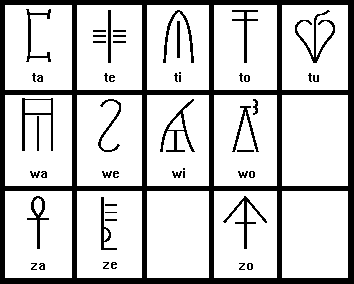- Language Description
- Linear B Script
- Indo-European Chronology (Greek)
- Ancient Languages of the East Mediterranean (essay)
 The
most ancient form of the Greek language was that used in Mycenae and on
Crete in the 16-11 centuries BC, until the Doric invasion. The only source
of its studies is the Linear B script invented on Crete in the 14th century
BC, and later spread to the continental Greece. Inscriptions written in
Linear B were found in Mycenae and other towns in Peloponnessus, but for
a long time were considered a pre-Hellenic language. In the beginning of
this century Ventris and Chadwick managed to decipher the syllabic alphabet,
and stated that it was used by Hellenic speakers.
The
most ancient form of the Greek language was that used in Mycenae and on
Crete in the 16-11 centuries BC, until the Doric invasion. The only source
of its studies is the Linear B script invented on Crete in the 14th century
BC, and later spread to the continental Greece. Inscriptions written in
Linear B were found in Mycenae and other towns in Peloponnessus, but for
a long time were considered a pre-Hellenic language. In the beginning of
this century Ventris and Chadwick managed to decipher the syllabic alphabet,
and stated that it was used by Hellenic speakers.
The Linear B used about 88 syllable signs and determinative logogramms. As it was inherited by Greeks from Linear A, another Cretan script of unknown origin, it did not reflect fully the Hellenic phonetics. For example, no distinction between long and short vowels existed in writing, but we know they were different in Greek even much later. Double consonants also could not be reflected. The script shows practically no r, l. At the end of the syllable we can't see any l, m, n, r, s, and this hardens research a lot. But anyway, the language remains Greek, with its complicated declension and conjugation system, Indo-European numerals like du-wo (two), ti-ri (three), e-ne-wo (nine), etc. And much progress was done in Linear B comparing to Linear A: for instance, Linear A does not distinguish the difference between [p] and [b], but such a distinction existed in Mycenaean Greek.